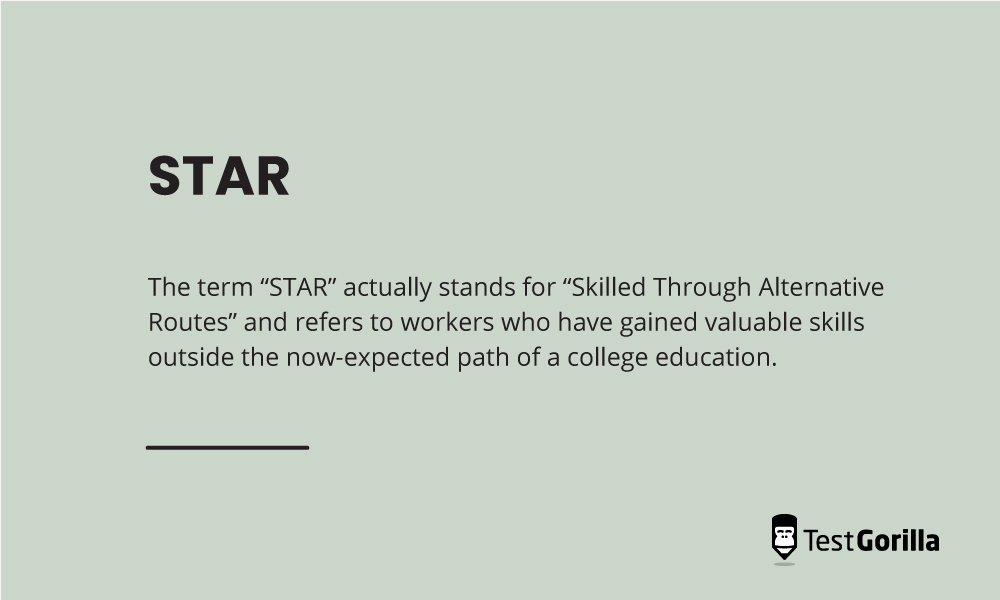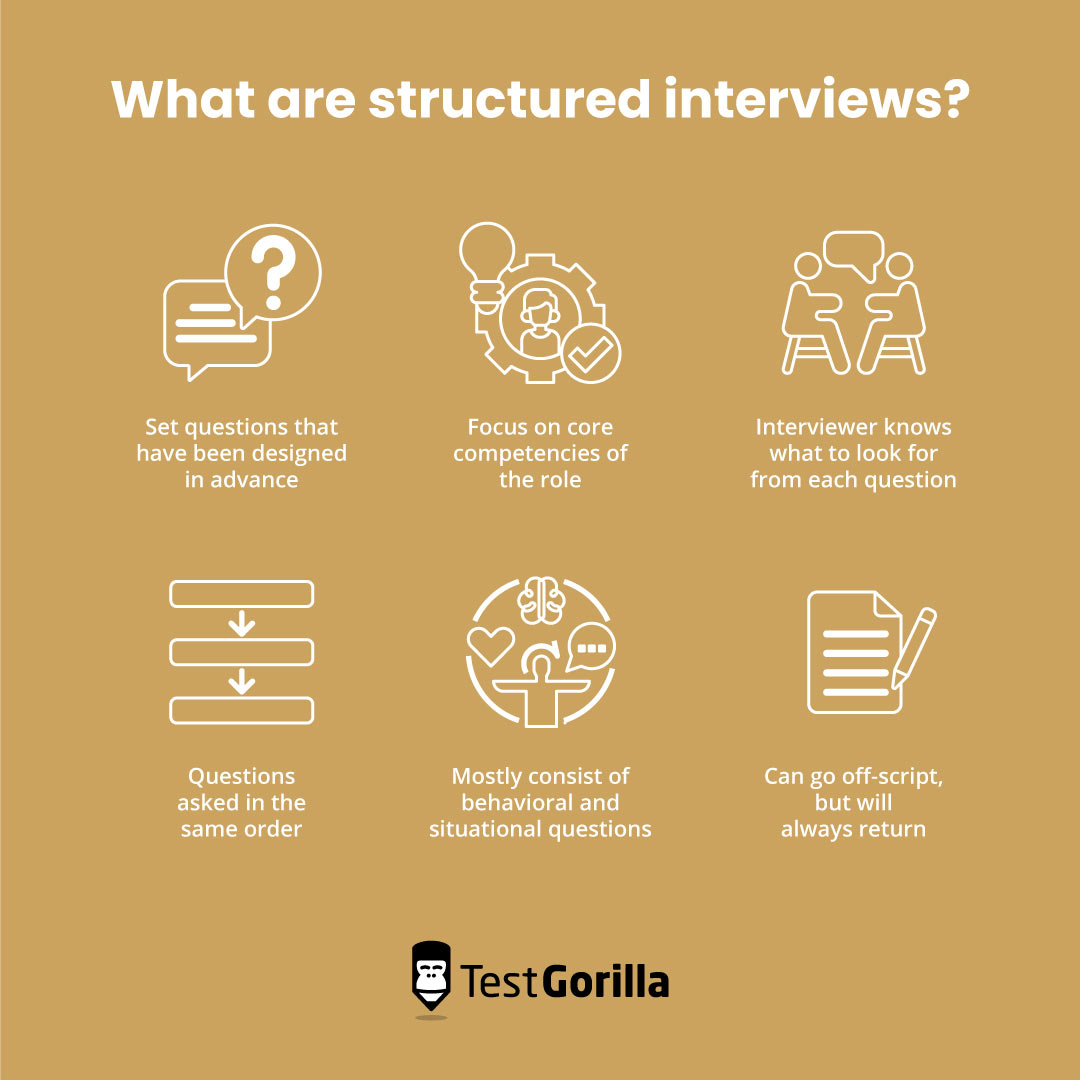We know how this headline sounds, but no, this blog post isn’t about helping Dua Lipa start a new career as a warehouse supervisor.
The term “STAR” actually stands for “Skilled Through Alternative Routes” and refers to workers who have gained valuable skills outside the now-expected path of a college education.
STARs make up 50% of the American workforce, and yet the traditional hiring techniques used by many employers – including resume review and degree requirements – exclude them from roles where they can demonstrate their value.[1]
In this blog, we show how opening your recruiting process to STARs with skills-based hiring not only improves their careers, but helps you create more diverse, innovative, and not to mention happier teams. Most importantly, we discuss how skills-based hiring can help tear the paper ceiling.
Table of contents
What are STARs?
As we mentioned above, STARs are workers who are “Skilled Through Alternative Routes” – in other words, those who have benefited from skills training outside of the traditional four-year college degree.
The phrase was coined in a 2020 National Bureau of Economic Research paper, and these “alternative routes” can include any number of learning experiences, including:
Community college
Workforce training
Certification programs
Military service
Personal interests
Volunteer work
The distinction of STARs from more mainstream candidates has emerged in recent years as a response to the phenomenon known as degree inflation – a boom in demand for workers with bachelor’s degrees in roles that didn’t previously require them.
What is the paper ceiling?
This boom has in turn created a degree gap concentrated in “middle-skill” jobs: roles that require some training after high school, though not a college degree. Many of these middle-skill jobs are affected by automation, and so employers reach for a four-year degree as a marker of basic computer literacy skills, needlessly cutting out many qualified candidates.
For instance, in 2015, 67% of production supervisor job postings asked for a college degree, although only 16% of then-employed production supervisors actually had one.[2]
When degree inflation becomes an obstacle to job seekers who don’t hold degrees, denying them access to jobs that they have the skills for, this is known as the paper ceiling.
Needless to say, this is a form of discrimination that stymies equality of opportunity. Organizations like Opportunity@Work are campaigning to help STARs’ skills be recognized by employers and to close the degree gap across professions. But why is this an issue that employers should be paying attention to when recruiting?
How does traditional hiring uphold the paper ceiling?
Degree requirements are the main obstacle stopping competent STARs from advancing in the workforce. Thanks to degree inflation, when workers don’t have the degree required to advance to “middle-skill” positions, they remain stuck in low-wage jobs. These are routinely mistaken for being low-skilled by employers and therefore aren’t seen to confer valuable skills down the line.
Without a degree and without employers assuming they are accumulating skills in their roles, they are stuck at one level. That’s the paper ceiling in action.
Even if employers are willing to look past the fact that STARs don’t have a degree, they might still view their skills as “unverified” and therefore, hiring them is seen as a gamble, while falling back on mainstream candidates is the “safer” option.
This is the vicious logic of the paper ceiling, and resumes are the traditional recruitment tool propping it up. This not-so-trusty document is what ensures that STARs’ applications are dead on arrival. Traditionally, resumes are evaluated manually, a time-consuming process that’s not primed to help employers identify what skills a candidate has. This is for two main reasons:
There’s no standard format to a resume, so they do not always contain the same types of information for every candidate
They often focus on responsibilities rather than skills
Because resumes don’t make it obvious how a candidate’s skills match up to a role, employers evaluating them reach for degree requirements to make sorting through them easier.
Even automated tools use the same flawed logic. 2021 research by Harvard Business School found that more than 90% of employers use recruitment management systems to filter or rank potential middle-skills (94%) and high-skills (92%) candidates.
The study found that these systems use college degrees and the presence of precise keywords as proxies for attributes including key skills, work ethic, and self-efficacy. They often also exclude candidates based on factors like a gap in employment, regardless of their other qualifications.
5 reasons organizations should tear the paper ceiling and hire STARs
Before we address the question of how you should go about hiring STARs, let’s discuss in some more detail what makes it worth doing in the first place.
Here are four reasons you should prioritize opening your hiring process to STARs.
1. They represent more than 70 million workers
Around 60% of American workers over the age of 25 do not hold a four-year degree, and according to the National Bureau of Economic Research paper cited above, STARs account for as many as 70 million workers total in the US workforce.
By ignoring them, you are narrowing your talent pool considerably and potentially missing out on many great candidates.
2. STARs have the skills you need
Resumes suck at giving recruiters the information they need to make an informed decision. And yet, they’re the dominant recruitment tool for screening candidates. Recruiters are left alone with their assumptions that STARs who are stuck in lower-wage (presumed lower-skill) roles don’t have the skills for higher-paid positions.
But this couldn’t be further from the truth. An Opportunity@Work report has shown that many STARs do frequently possess the skills required for so-called “higher-skill” roles.[8] This means that it’s actually in the interest of employers to tear down the paper ceiling – without it, they can access a bigger pool of talent.
3. Excluding STARs disproportionately affects minority candidates
STARs are also a very diverse group since many of the reasons people pursue alternative routes for skills training are related to issues of marginalization. These might include:
Disabilities. Living with a chronic illness might inhibit an individual’s ability to participate in academic study environments and instead prompt them to turn to more flexible training sources, such as on-demand online courses.
Income inequality. A lack of family wealth prevents many people from being able to pursue higher education, due to both the cost of tuition and the need to contribute financially to their household.
Discrimination in academic settings. For example, in the U.K. alone, exclusion rates are five times higher for Black Caribbean children than White children, which has long-term effects on their educational outcomes.
Caring responsibilities. Women frequently face more pressure than men to cede their careers to their family’s needs. This was thrown into particular visibility during the Covid-19 pandemic when the rate at which women with children under 10 were considering leaving the workforce was 10% higher than men in the same group.
Excluding STARs from the workforce is therefore one of the many ways employers fall short of their intentions to be equal-opportunity employers. In fact, adding a four-year degree requirement alone automatically screens out 76% of African Americans and 83% of Hispanic workers as well as 81% of Americans in rural communities.[3][4]
4. Diverse hiring promotes employee wellbeing and innovation
As we’ve just seen, hiring STARs is likely to bring more diversity to your hiring in terms of gender, ethnicity, and more.
This benefits your company culture because diversity in these areas is linked to better employee wellbeing and retention.
For instance, research has found that higher levels of gender diversity and the presence of HR policies focused on this issue are linked to lower employee turnover, while more than half of Canadians of color who anticipate bias in the workplace are planning to quit.
Not only that: Hiring STARs also brings a diversity of thought and experience to your teams. Even if a STAR hire comes from a similar demographic to your existing team members, the alternative routes through which they’ve gained their skills give them a different perspective when it comes to approaching business challenges.
This is linked to increased innovation according to Deloitte research, which shows that diversity of thinking increases innovation by about 20%.[7]
Finally, the shift in thinking that enables you to hire STARs also empowers you to access the full potential of this push for diversity because it requires you to commit to:
Fostering an atmosphere of acceptance and respect
Creating a more honest flow of communication between leaders and employees where employees don’t feel they need to hide any part of their past to be taken seriously
Showing a real investment in individuals by taking the time to understand different backgrounds
This naturally creates a more cohesive culture and develops the willingness to change that researchers say is essential to nurture in order to fully benefit from increased diversity.
5. Tearing the paper ceiling makes your hiring more effective
The simple fact is that the quality of your hiring will improve if you open it up to STARs.
This is because college is not the only place that people can learn – it’s not even the guarantee of key skills many employers use it for.
As an employer, the paper ceiling is not your friend. Every degree curriculum is different, and the quality of education can vary widely between different college experiences. It’s not necessarily safe for employers to assume that a candidate has the specific skills required for a role just because they have a degree in a relevant discipline.
This even applies to basic digital skills. One survey conducted by the UK government found that employers believed the top 10 skills graduates were lacking were:
Basic IT skills
Data ethics
Machine learning
Programming
Data processing
Data communication skills
Knowledge of emerging technologies and solutions
Advanced statistics
Analysis skills
Data visualization
The lesson here isn’t necessarily that STARs have these skills and graduates don’t. It’s that shedding arbitrary standards like degree requirements gives employers access to a wider pool of candidates who are equally as likely to be skilled. Tear the paper ceiling, and you might just find your dream hire.
How skills-based hiring helps tear down the paper ceiling
In contrast to traditional methods, skills-based hiring methods like pre-interview testing offer a new way to recruit that enables employers to:
Identify key skills areas for each role they’re hiring for
Test every candidate in each skill
Compare and shortlist candidates based on this objective data
Reduce bias in the interview process
This has many obvious benefits for employers and STARs.
First, it removes bias and levels the playing field for candidates of all backgrounds. Recruiters can evaluate all candidates on whether they have the key skills for the role before finding out where they got those skills from – a comparatively unimportant aspect of their background.
This is particularly true when you adhere to some of the best practices we outline below. Indeed, according to our State of Skills-Based Hiring 2022 report, 91.1% of organizations saw an increase in diversity after switching to skills-based hiring.
As well as showing you the skills each candidate has, skills testing also enables you to objectively measure candidates’ proficiency in each skill area and compare them to one another using data. This reduces the temptation to fall back on old habits like assuming that four-year degree-holders are intrinsically more skilled than STARs.
Skills-based methods don’t stop once you’ve shortlisted candidates, either.
Structured interview techniques can also help you reduce bias in interviews, particularly when backed up by the data you’ve already gathered using skills testing. Unlike traditional unstructured interviews in which interviewers improvise questions that don’t necessarily target core competency areas for the role, structured interviews require that you:
Ask candidates the same questions
Ask these questions in the same order
Evaluate their answers based on pre-agreed criteria
For instance, you might agree with the managers of a marketing team that when asked about how they would approach a sudden hiccup in a social media campaign, a “good” answer would be one in which the candidate mentioned at least one of the following:
Pausing all paid ads immediately
Notifying all the stakeholders
Calling a meeting with the marketing team to present a solution
Interviewers could even score the answer out of three and compare scores at the end of the interview.
This framework reduces interviewer bias against STARs for having unconventional backgrounds because it prompts them to interrogate their reasoning for their assessment of a candidate, comparing their subjective impressions against their more objective data.
This is an improvement on the traditional unstructured interview in which a hiring manager might not have specific questions to ask and therefore ask harder-hitting questions to candidates whom they may have an unconscious bias against.
Hiring managers might also lack guidance about how to interpret candidates’ answers to questions like the above. This might cause them to fall back on a “gut feeling,” which they wouldn’t even realize was informed by the fact that one candidate attended a high-ranking college while the other learned their skills on the job.
With a structured interview, the benchmark for a good answer is set beforehand, making this comparison between the two answers much clearer, even if the hiring manager isn’t an expert in the skill area they’re hiring for.
Finally, skills-based methods also go hand-in-hand with employee development after hiring, providing avenues for continuing skills training to help STARs better apply their skills in a new work environment and fill in any gaps in their skill sets.
3 skills-based hiring strategies you can use to attract STARs
Now that you know why skills-based hiring is beneficial for employers and STARs – and why traditional hiring isn’t – it’s time to talk about how you can apply skills-based methods in your own organization.
Here are our top tips for taking down that paper ceiling and attracting superstar talent.
In a hurry to attract STARs to your organization? Here’s a quick breakdown of our strategies:
Skills-based hiring strategy | Example actions |
Identify key skills areas for open roles | Assess the skills of your employees to see common skills in each role; Use a skills gap analysis to identify missing skills |
Replace resumes with skills testing | Stop using resumes to screen applications and instead use skills testing to identify highly-skilled candidates |
Emphasize how you’re reducing bias | Summarize your anti-bias methods, like skills testing, in your job ads; Create a dedicated page on your careers portal to discuss your approach to eliminating bias |
1. Identify key skill areas for open roles with a skills gap analysis
First up: Assess the skills of your employees to find the skills that your team has and that are required for each role.
To push this even further, use a skills gap analysis to identify the key skills that new hires could bring in that you don’t already have. You almost certainly have a skills gap in your workforce: 87% of companies worldwide report either already having one, or expect to have one within a few years.[8]
Using skills assessments to audit the skills in your marketing team might reveal that communication skills and SEO copywriting skills are essential attributes for a new hire.
However, it might reveal that there is a skills gap when it comes to social media, and you can therefore focus your outreach efforts on bringing social media management skills into the fold.
2. Replace resumes with skills testing
You knew this one was coming, right?
Replace degree requirements as a screening tool with pre-employment skills testing in the core skill areas you’ve identified by assessing your employees and conducting a skills gap analysis.
A minority of roles might truly require a complex degree, however, in these cases, a skills test would still pick up the candidate’s readiness for the role. Their degree would be used only as a tool for contextualizing their expertise later in the hiring process.
This step might feel scary, but trust us: Our State of Skills-Based Hiring report found that 92.5% of organizations saw a reduction in mis-hires after switching to skills-based hiring.
3. Emphasize how you’re reducing bias in your hiring process
To make the most of these changes and boost applications from STARs, you need to ensure that STARs know about them.
Show that you’re actively tackling bias throughout your hiring process, whether in your job ads themselves or on a dedicated page on your website. There, you should explain clearly:
How you use skills tests to review and compare candidates’ skills anonymously
What the structured interview process involves and how it ensures that they are assessed fairly
What the timeline will be for evaluation and decision-making
That you don’t care where candidates’ skills come from, only that they have them
This demonstrates to STARs right from the outset of your hiring process that there aren’t any hidden obstacles, and that you are giving them every opportunity to succeed.
It also creates a good candidate experience from the start, which has benefits for both hiring and retention. Handy!
Tear the paper ceiling with skills assessments
We know that pop stars reskilling into corporate roles is a fun concept, but as far as we’re concerned, optimizing your hiring process for STARs is just as exciting.
As we’ve seen, it can make your recruiting process and, by extension, your organization:
More diverse
More rewarding to work in
More focused on learning and development
More innovative
To hit the ground running applying the strategies we’ve outlined above, check out our guide to the skills-based hiring hacks most employers aren’t even using.
Or, if you’re ready to dive right in and find a candidate who will add something unique and valuable to your company culture regardless of their educational background, check out our Culture Add test.
Sources
Tear the Paper Ceiling, “About STARs.” Retrieved May 24, 2023. https://www.tearthepaperceiling.org/about-stars
Fuller, Joseph; Raman, Manjari. (October 2017). “Dismissed by Degrees”. Harvard Business School. Retrieved March 02, 2023. https://www.hbs.edu/ris/Publication%20Files/dismissed-by-degrees_707b3f0e-a772-40b7-8f77-aed4a16016cc.pdf
“Highest Educational Levels Reached by Adults in the U.S. Since 1940”. (March 30, 2017). United States Census Bureau. Retrieved March 02, 2023. https://www.census.gov/newsroom/press-releases/2017/cb17-51.html
Marré, Alexander. “Rural Education at a Glance, 2017 Edition”. (2017). US Department of Agriculture Economic Research Service. Retrieved March 02, 2023. https://www.ers.usda.gov/publications/pub-details/?pubid=83077
Bourke, Juliet. “The diversity and inclusion revolution: Eight powerful truths”. (January 22, 2018). Deloitte Insights. Retrieved March 02, 2023. https://www2.deloitte.com/us/en/insights/deloitte-review/issue-22/diversity-and-inclusion-at-work-eight-powerful-truths.html
Bock, Laszlo. “Here’s Google’s Secret to Hiring the Best People”. (April 7, 2023). WIRED. Retrieved March 02, 2023. https://www.wired.com/2015/04/hire-like-google/
“Navigating with the STARs: Reimagining Equitable Pathways to Mobility”. (2020). Opportunity@Work. Retrieved March 02, 2023. https://opportunityatwork.org/our-solutions/stars-insights/navigating-stars-report/navigating-with-the-stars-report-download/
“Mind the [skills] gap”. (January 27, 2021). McKinsey Chart of the Day. Retrieved March 02, 2023. https://www.mckinsey.com/featured-insights/sustainable-inclusive-growth/chart-of-the-day/mind-the-skills-gap
Related posts
Hire the best candidates with TestGorilla
Create pre-employment assessments in minutes to screen candidates, save time, and hire the best talent.
Latest posts
The best advice in pre-employment testing, in your inbox.
No spam. Unsubscribe at any time.

Hire the best. No bias. No stress.
Our screening tests identify the best candidates and make your hiring decisions faster, easier, and bias-free.
Free resources
This checklist covers key features you should look for when choosing a skills testing platform
This resource will help you develop an onboarding checklist for new hires.
How to assess your candidates' attention to detail.
Learn how to get human resources certified through HRCI or SHRM.
Learn how you can improve the level of talent at your company.
Learn how CapitalT reduced hiring bias with online skills assessments.
Learn how to make the resume process more efficient and more effective.
Improve your hiring strategy with these 7 critical recruitment metrics.
Learn how Sukhi decreased time spent reviewing resumes by 83%!
Hire more efficiently with these hacks that 99% of recruiters aren't using.
Make a business case for diversity and inclusion initiatives with this data.





















